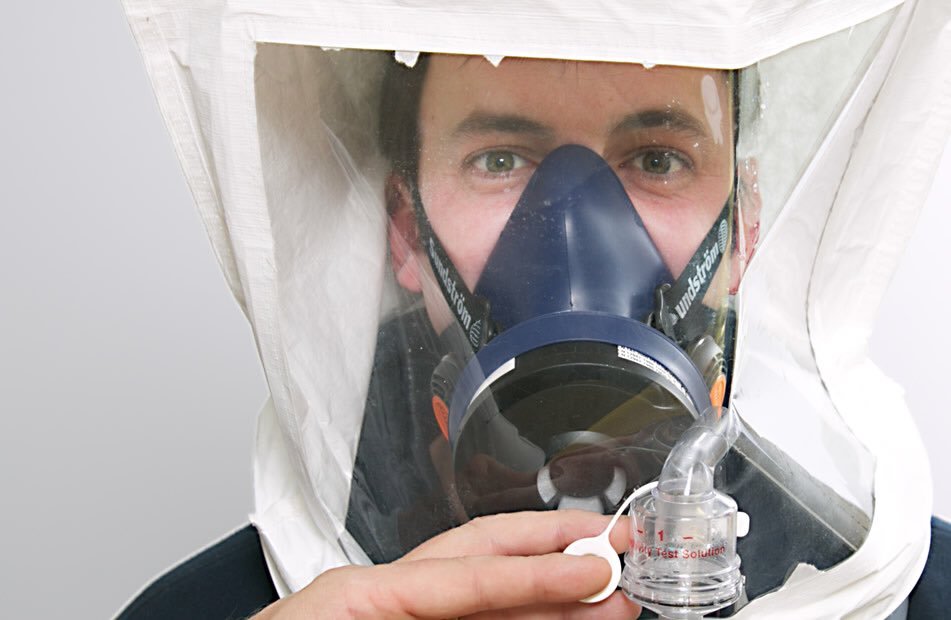Legal Requirements for Employee Face-Fit Testing
Companies should undertake periodic face-fitting tests on masks because one-off tests do not sufficiently protect workers. Also, if you don’t know already, masks need to have a maintenance record.
HSE guidance is very clear about this. COSHH ACoP L5 Dec 2013 states: “Tight-fitting RPE (i.e. full and half masks) should be face-fit tested, using a suitable method, by a competent person (see regulation 7 of the MHSW Regulations and regulation 12(4) of COSHH).
“Fit testing will need to be repeated when there is a change in equipment or the facial characteristics of the wearer that could affect the fit. Loose-fitting devices, such as powered respirators with a visor or hood, need not be face-fit tested but still need to fit observably close to the face.”
Therefore, it’s possible that prior to this guidance, workers may only have ever had one face fit test.
HSE’s HSG 53 – respiratory protective equipment at work, a practical guide, which was published in May 2013, raises some important, related issues around face fitting.
For instance, the guidance says: “It is also good practice to have a system to ensure repeat fit testing is carried out on a regular basis. This is especially important when RPE is used frequently as a primary means or exposure control, e.g. annual testing for workers involved in licensed asbestos removal. If there are any changes to a person’s face though, for example, weight loss/gain, scars etc., a repeat fit test will be necessary.”
In our company, during the first year of testing several people were identified where the mask they were originally tested for no longer fit. These people had not had facial surgery and had no change in weight so the old system would not have needed a repeat test.
In addition, several people were using masks for long periods whereas the HSE guidance recommends: “It is recommended that continuous wear time for tight-fitting (unpowered) RPE is less than an hour, after which the wearer should take a break.”
Another challenge for employers is workers that have designer beards. Our business changed face-fit test companies at the start of this year. Our previous supplier would test people with beards – and most of them actually passed the face-fit test, with some exceptions for the designer beards and designer stubble. The new provider refuses to fit anyone with a beard.
Guidance from HSE recommends that those with facial hair, scars, wrinkles or marks which prevent a tight seal in the area use a loose-fitting device: “The wearer needs to be clean-shaven around the face seal to achieve an effective fit when using tight-fitting facepieces. Training is a good opportunity to make employees aware of this. If workers have beards, or are unable to be clean-shaven, a tight-fitting device will not be suitable so an appropriate loose-fitting device should be chosen.”
The HSE’s guidance – is your mask protecting you? is definitely worth giving to mask users to raise this important point as having this knowledge will help provide them with better protection.
You can use one of two face-fit testing methods – either quantitative or qualitative – but whichever one you choose, they need to be carried out with the same exercises and conditions and with a competent person doing the face fit test.
The key points are:
- No smoking, drinking, eating or chewing gum for 15 minutes before the test, as this could affect the results.
- No beards or stubble where the mask seals because this affects the fit (some goatee beards are ok but it depends where the mask sits. on the wearer; there may also be an issue with longer side burns)
- A test must be done for each different type of mask – so anyone wearing a dust mask and a halfmask will need more than one test.
This quantitative test is a precise method that uses a device to count the particles in the air outside the mask and compare them to what is inside the mask.
The qualitative test uses the wearer’s sense of smell and taste to detect any leaks in the mask’s seal.
During the Face Fit Test a series of 60 second exercises are carried out to determine if the mask fits correctly in this order:
- Normal breathing;
- Heavy breathing – walking/stepping with the mask on;
- Turning head from side to side;
- Moving head up and down;
- Talking;
- Heavy breathing – walking/stepping with the mask on;
- Normal breathing.
Note: In the quantitative test – if the machine is American – users may also come across the requirement to grimace.
HSE has produced guidance on how to train users sufficiently. An appropriate training programme could cover areas including why RPE is needed, how it works and how to wear and check the RPE correctly.
The final, important point, to remember is that there is a requirement (HSG 53) for an over 28-day mask maintenance record. The guidance states that thorough tests should be carried out at least once a month, or if the RPE is only used occasionally, the interval for testing shouldn’t exceed three months.
The guidance provides five key points that need to be followed when carrying out RPE maintenance:
- Follow the manufacturer’s instructions.
- A competent person should carry out the work.
- Keep records (see figure 7 for an example).
- Ensure the intervals for maintenance are appropriate.
- The maintenance programme should reflect the complexity of maintaining the RPE.
HSG 53 adds: “Ideally, any parts that require replacing will be sourced from the original manufacturer of the RPE. This will ensure any replacement parts continue to allow the equipment to operate as originally intended and perform to the standards that ensure the RPE offers the protection stated by the manufacturer.”
The guidance makes it clear that employers must keep records of examination and testing, and any repairs made, for at least five years.
Key maintenance tasks include:
- changing any replaceable filters;
- cleaning the device;
- valve maintenance and replacement;
- checking the straps for damage;
- checking the battery charge and flow rate for powered devices.
Maintenance records can be on your own form or a manufacturers.
By Linda McGravey


